

Wearable Electronics Class. In the class, you will learn how to build wearable electronics and program interactions using the Arduino software.

Sewing with Conductive Thread. Conductive Thread Basics So you’d like to dip your toe into e-textiles, but you’re not sure what this conductive thread is all about.
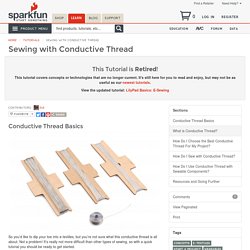
Not a problem! It’s really not more difficult than other types of sewing, so with a quick tutorial you should be ready to get started. Sewn Circuits. A stuffed camera’s flash actually goes off when a button on the back is pressed!
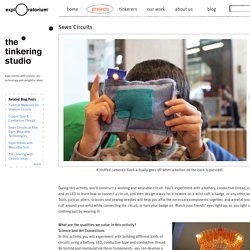
Sewing can be challenging and rewarding at the same time A great deal of facilitation happens between participants, with more experienced sewers showing the ropes to novices When we offer this activity at the museum, there is an age limit of 10+, but no such thing at home! Soft Electronics Tutorials. Specialized Materials The tools and materials for creating soft circuits are pretty standard: you need your electronic components and their tools, and your soft materials and their tools.
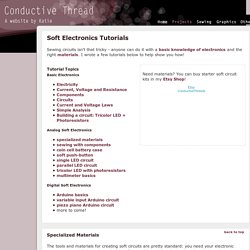
Anything that conducts electricity can be interesting here: snaps can be switches; hooks and eyes can too. There is only one special ingredient: conductive thread. DIY PROJECTS. To Sew Electric and the marvelous world of electronic textiles!
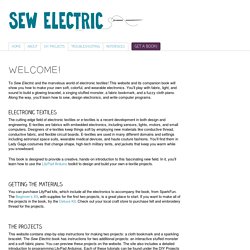
This website and its companion book will show you how to make your own soft, colorful, and wearable electronics. You’ll play with fabric, light, and sound to build a glowing bracelet, a singing stuffed monster, a fabric bookmark, and a fuzzy cloth piano. Soft Electronics. LED Bracelet. AdWords We use AdWords to deploy digital advertising on sites supported by AdWords.
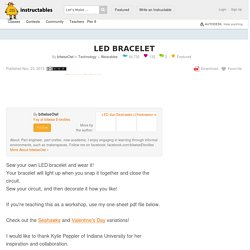
Ads are based on both AdWords data and behavioral data that we collect while you’re on our sites. The data we collect may include pages you’ve visited, trials you’ve initiated, videos you’ve played, purchases you’ve made, and your IP address or device ID. Ultimate Felt Bracelet with LEDs. Hardware Hump Day: 3 Soft Electronics Tricks. Happy Hardware Hump Day!
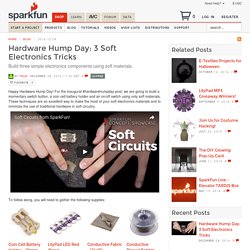
For the inaugural #hardwarehumpday post, we are going to build a momentary switch button, a coin cell battery holder and an on/off switch using only soft materials. These techniques are an excellent way to make the most of your soft electronics materials and to minimize the use of traditional hardware in soft circuitry. To follow along, you will need to gather the following supplies: LilyPad LED Red (5pcs) BraceLED 2.0. I worked hard to make the first BraceLED a cool project and a good Instructable...
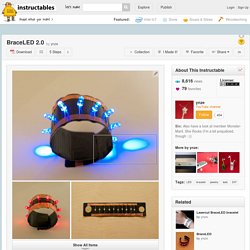
I really did! ...and yet, a few days after publishing, I got uncomfortable. Restless. Although I had plenty of other things to do, I couldn't get my mind off the BraceLED. It seemed to me that I had left something out that should be in. Well, you know... BraceLED 1.0 has a few (non-critical) problems, that are more or less fixed in this version: - The LED's are more secure connected to the circuit. - The layout and design of v2.0 is much more straightforward - Because of that, BraceLED 2.0 is (even more) easier to make - In version 1.0, switching on the led's is a bit awkward, using a loose supermagnet.
I will keep BraceLED 1.0 online, because it has it specific charms that are different or altered in this new version (I like the gap underneath the leds in v1.0, for instance). Project: eTextiles with Cross Stitch and LEDs in Parallel. I've been quite fascinated by eTextiles and wanted to try a project combining my love for sewing with electronics.

Growing up I did a lot of sewing with my mother, including making my own clothes, cross stitch and tapestry projects. At Tech Age Kids we explore how tech is used in all sorts of creative ways, one of those being electronics in fabric crafts and fashion. What is eTextiles? eTextiles, is the process of using electronics in textiles to add function and / or decoration. It is also known as smart textiles, wearable fashion, eFashion or smart fabrics. Today there are many exciting creations and useful developments in eTextiles. eTextile Circuit with LEDs The electronic components for eTextile projects are specifically designed for fabrics and sewing with conductive thread. Below is a simple diagram of our circuit. Light-Up Tapestry Robot Project I like the idea of teaching my boys sewing skills.
Materials Needed Below is a list of all the materials we used for this project. LED Pipe Cleaner Bracelet. LED Foam Bracelet. HOW TO GET WHAT YOU WANT. Welcome to the KOBAKANT DIY Wearable Technology Documentation Workshops least likely scenario This workshop is part of a course at the Ernst Busch Hochschule in Berlin.
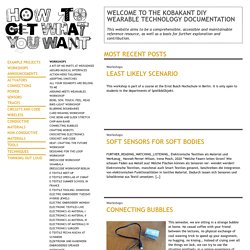
It is only open to students in the departments of Spiel&&Objekt. Workshops soft sensors for soft bodies FURTHER_READING_WATCHING_LISTENING_ Elektronische Textilien als Material und Werkzeug_ Hannah Perner-Wilson, Irene Posch, 2020 “Welche Fasern leiten Strom? Workshops connecting bubbles This semester, we are sitting in a strange bubble at home. Sensors 6 really wearable sensors The textile sensors on our website are often not designed to be manipulated with your hands. ProtoSnap - E-sewing Kit: Getting Started Guide, Part 2. ProtoSnap - E-sewing Kit: Getting Started Guide, Part 2 Skill Level: Beginner by Dia | May 25, 2012 | 5 comments.